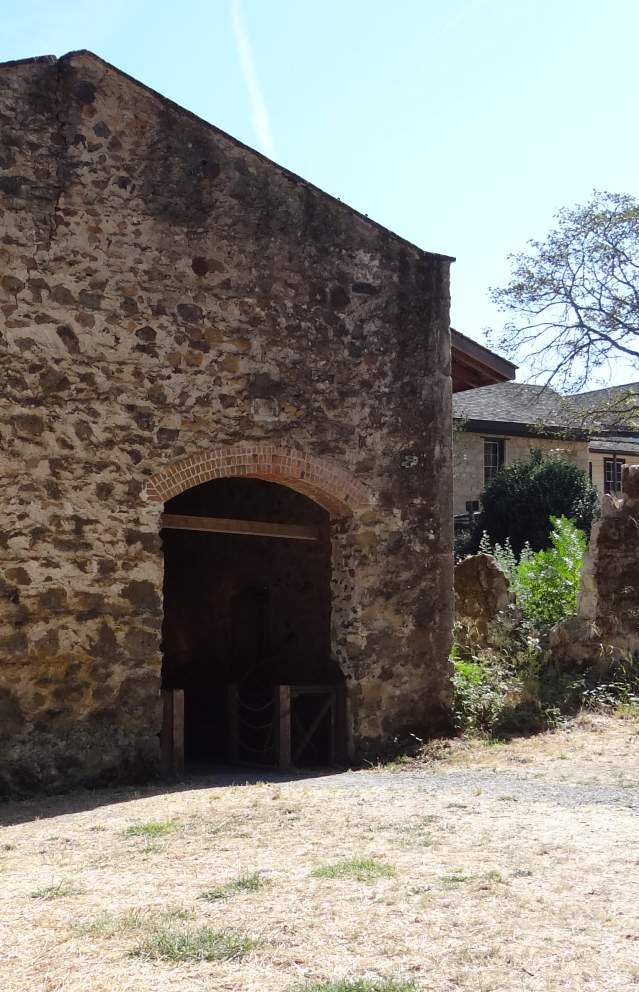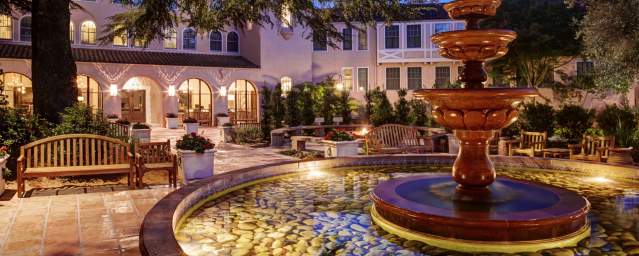A Golden Land
Sonoma met many challenges as it moved into the 20th century, among them war and Prohibition. But increasing tourist traffic – and a few famous names - helped Sonoma become the modern city it is today.
Jack London Comes to Town
One of the Sonoma Valley’s residents became internationally famous.
Writer Jack London fell in love with the region after a visit to Glen Ellen in 1903. Two years later, he and his new wife Charmian Kittredge bought an exquisite property in the hills above the little village and named it Beauty Ranch. As he published his wildly popular novels, London also became a “scientific farmer” and made modern improvements to the way he and Charmian raised livestock and crops. All of the valley mourned when he died at age forty in 1916.
In 1913 a silent movie version of London’s novel Valley of the Moon was partially filmed at his home Wolf House, now part of Jack London State Historic Park. In 1941 a star-studded film version of his book The Sea Wolf premiered at the Sebastiani Theater. Celebrities such as Edward G. Robinson, Ida Lupino, John Garfield, and Ronald Reagan first went out to the Beauty Ranch where the Chamber of Commerce hosted a BBQ, overseen by Charmian London.
Boxers and Baseball Players
In the years before World War I, athletes came to the Springs area to train in the fresh air, away from city temptations. Boxers were among the first to arrive, and their sessions in the Sonoma Valley were covered by San Francisco newspapers.
Baseball was hugely popular around Sonoma, and starting in 1913 the San Francisco Seals minor-league team started training in Boyes Hot Springs. They played against local teams and in their first year in the Valley, the Seals played the Chicago White Sox at the baseball park in Boyes. The stands were packed with locals and out-of-towners, including (according to legend) Jack London. The Seals trained in the Valley until 1950.
Prohibition and Revival
Sonoma Valley wines continued to win prizes at fairs and expositions, but all of that came to an end in 1920, when Prohibition went into effect all over the country.
To curb the restrictive liquor laws, local winemakers snatched up licenses to make medicinal and sacramental vintages. Grape growers turned their produce into juice and raisins, but everyone else was doing the same, and the market soon collapsed. Families could make up to two hundred gallons of wine a year for their personal consumption, but commercial wineries were devastated, many closing for good.
The survivors limped along until 1933, when Prohibition was finally repealed, and despite the challenges of getting back into business, Sonoma’s winemakers were committed to their craft and made their way back. By 1939, vintners could send their wines to the Golden Gate International Exposition in San Francisco. New wineries opened during World War II, and older enterprises came fully back to life. Newsreel companies came to the valley to film the grape harvest in the 1940s, and the footage was shown to civilians around the country and at American army bases.
The War at Home
Sonomans jumped into the war effort when the United States entered World War II in 1941, and local organizations held blood drives and scrap metal drives.
The Sonoma Valley Woman’s Club turned over its clubhouse on First Street East to the Red Cross, and its members gave many volunteer hours to its work.
Events to sell war bonds took place around town and in the Plaza, which continued to be the meeting place for everything important to Sonoma. In 1945, an “Army Day” was held on the Plaza, and the festivities included the presence of an armored vehicle called an M8 Scout Car, complete with gun turret. For every war bond sold that day, a local child went for an exciting ride in the armored vehicle.
Famous Far and Wide
Interesting and creative people have always been drawn to Sonoma.
Henry “Hap” Arnold was famed as one of the world’s first military aviators. He was the commanding general of the Army Air Forces during the war, and he and his wife visited Sonoma in 1943. They fell in love with the valley and bought property in Glen Ellen after Arnold retired. He was a beloved figure around town, and mingled with everyone at local watering holes and stores. The thoroughfare now called Arnold Drive was named for the general in 1950.
One of the most renowned food and cookware brands not only got its start in Sonoma, but it was name for the valley: Williams-Sonoma. Chuck Williams moved to Sonoma in 1947 and worked as a contractor. After a trip to France in 1953 he opened a small shop on Broadway and started a small housewares business. It became so popular by 1958 that Williams moved his business to San Francisco, but he continued to support Sonoma charities. In 2014 the company came back to town, and opened a store in its original building.
Sonoma’s influence in the wine and food world also drew internationally renowned food writer M.F.K. Fisher. She was living in the Napa Valley and then moved to Glen Ellen in 1971. She wrote lyrical books and essays about Sonoma and California’s food culture, luring many to the Valley of the Moon. Today she is celebrated as one of the early pioneers who defined American cuisine.
A New Generation of Tourists
In the years after World War II, Sonoma’s winemakers got creative and started offering something new in order to bring in new customers: wine tasting. Their advertising efforts, as well as tastings and winery tours, started to pay off in a big way. In the 1950s trade organizations printed maps of California’s wine regions, including Sonoma, and people flocked into the valley. Tastes in wine had also changed, and people wanted to see where and how their favorite vintages were made.
Wine writers began to notice Sonoma in the 1960s and 1970s, and advertising also moved into radio and television. New wineries started opening in the 1970s, as well. This decade was also the era of hippie “back to the land” movements, and young people started moving to Sonoma County and the Sonoma Valley itself, following the Summer of Love in 1967.
Sonoma also held the fall Vintage Festival, as well as Plaza art festivals, which brought in visitors. Tourists from around the world began to flock to Sonoma as the 1980s got underway, and as tastes in food and wine changed, local wineries and restaurants led the way.
Uneasy Growth
Sonoma’s fame also brought new residents. Between 1940 and 1980 the population went from 1,100 to 6,000, with the current population at 11,000. But popularity led to conflicts about growth.
In 1961 the State of California proposed building a four-lane freeway along Highway 121 and Arnold Drive, the main routes into town from Highway 37. The freeway would then meet up with Highway 12 east of Glen Ellen and continue out to Santa Rosa. Locals were aghast, and a public outcry kept the project from going forward.
Over the years citizens also preserved Sonoma’s rural character by successfully opposing the construction of some multiple housing units and a large resort hotel, while also preserving open space.
Sonoma Today
Sonoma has found a fine balance between its storied past and its desire to retain the valley’s natural beauty, while keeping one eye on the future.
Farmers markets co-exist with businesses and services aimed at both visitors and locals. Hiking and biking trails provide the opportunity for outdoor enjoyment. Historic sites abound, and old buildings now house modern stores and restaurants. Sonoma’s wine and food culture, so central to the city’s heritage and to life today, is known around the world.
Jack London once wrote that Sonoma was “a golden land,” and the city still shines today. Whether you picnic in the Plaza, walk through historic rooms, taste fine vintages, enjoy a spectacular meal, or find the perfect gift, you will have an experience unlike any other when you visit The Valley of the Moon.






